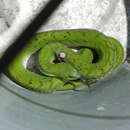ar
الأسماء في صفحات التنقل


When disturbed C. resimus responds as other members of its genus does, by inflating its body with air and hissing and puffing ferociously. It may also coil up in preparation to strike (Spawls et al., 2002).
Velvety-green night adder
These snakes reach a maximum size of about 75 cm, the average size is between 30 to 60 cm. The dorsal color is green and the shades vary from grass green to a deep forest green. As indicated by the name, the scales are soft and velvety. There are usually two distinct, narrow pale dorsolateral stripes that run the length of the body. A scattering of black scales sometimes form indistinct rhomboid shapes on the back and oblique dark bars on the flanks. On the head there is sometimes a black V-shaped mark. The chin and throat scales are distinctively yellow and the ventral scales can be yellowish, cream or pearly. The tongue is pale blue and black (Spawls et al., 2002)
There are 19 to 21 scale rows at midbody, 131 to 152 ventral scales, and 15 to 25 subcaudal scales (Spawls et al., 2002).
Known to consume toads and frogs (Ineich et al., 2006; Spawls et al., 2002).
Central and eastern Africa from Nigeria east to Sudan, Uganda, Ethiopia, Rwanda, burundi, Zaire. An isolated population occurs in western Angola (McDiarmid et al., 1999).
C. resimus is active both during the day and night. When inactive, it hides in holes, brush piles, under ground cover and other similar shelters (Spawls et al., 2002).
C. resimus occurs in coastal savannas and thickets, and dry and moist savannas and woodlands from sea level to 1800 m (Spawls et al., 2002).
No other African snake is both vivid green and stout (Spawls et al., 2002).
Holotype: ZMB 4370
Type-locality: "Sennâr, vom Gebel Ghule" [Jebel Ghule, Sennar, Sudan]
Causus resimus is a viper species found in isolated populations distributed across tropical Africa.[2] No subspecies are currently recognized.[3] Like all other vipers, it is venomous.
Averages 30–60 cm in length with a maximum of 75 cm.[4] They appear relatively stout.[2]
The head is short and slightly distinct from the neck with an upturned snout. The circumorbital ring includes 2 preoculars, 2 postoculars and 1–2 subocular scales. There are 6–7 sublabials. The temporal scales number 2+3 (rarely 2+4).[2]
Midbody there are 19–22 rows of faintly keeled dorsal scales that have a velvety appearance. There are 131–155 ventral scales. The anal scale is single. There are 16–27 paired subcaudals.[2]
The color pattern consists of a green ground color that may be anything from bright green to olive. This is overlaid with a series dark inverted chevron-like crossbars that run down the back, similar to C. defilippii and C. rhombeatus. The chin and throat are yellow. The belly is a yellowish, cream or pearly in color.[2]
Green night adder,[2][4] velvety-green night adder,[5] green viper.[6]
Central and eastern Africa from Nigeria east to Sudan, Uganda, Ethiopia, Kenya, Somalia, and south to Tanzania, Rwanda, Burundi and DR Congo. An isolated population occurs in western Angola. The type locality is listed as "Sennâr, vom Gebel-Ghule" (Jebel Ghule, Sennar, Sudan).[1]
Prefers low-lying moist savanna, wooded hills, high grasslands, and the riparian zones of rivers that run through swamps, rocky gorges, coastal scrubland and semi-deserts. Also known to occur in man-made habitats, such as abandoned quarries, sugar cane plantations and in borrow pit pools along roads.[2]
If disturbed, they inflate themselves and put on a ferocious hissing and puffing threat display. The front part of the body is raised and coiled, from which position they tend to make sweeping and lashing strikes as opposed to a stabbing motion. They are mostly terrestrial, but are also good swimmers and have been known to climb into sedges in pursuit of prey. Despite their common name, they are diurnal and are often seen basking. They hide under ground cover when not active.[2]
Causus resimus is a viper species found in isolated populations distributed across tropical Africa. No subspecies are currently recognized. Like all other vipers, it is venomous.